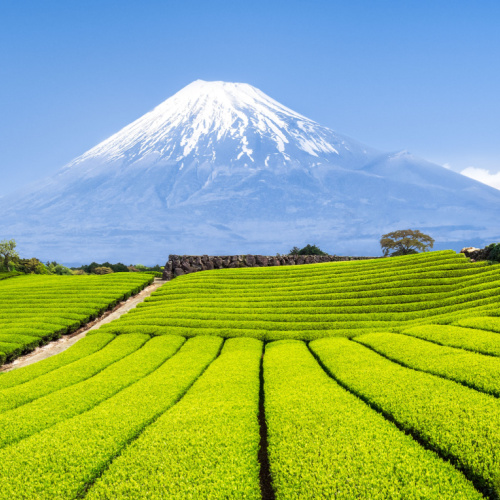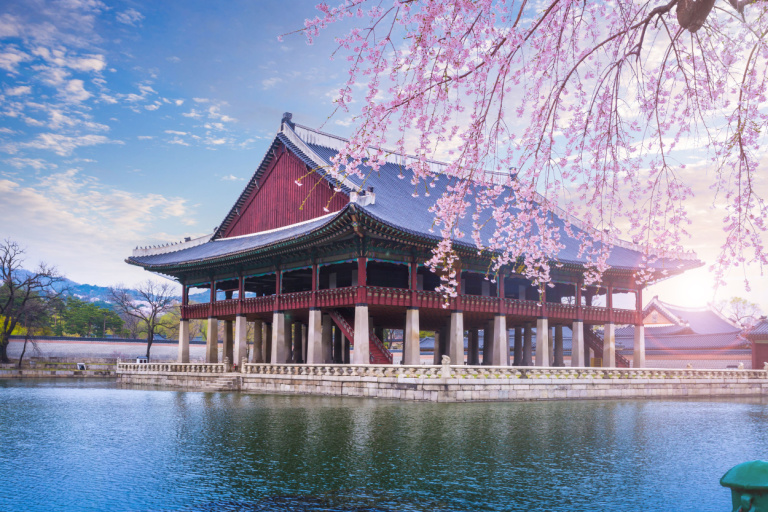
mapman/Shutterstock
When Is the Best Time to Visit Asia?
The best time to visit Asia is during the shoulder seasons of spring (March to May) and fall (September to November). These periods boast incredible, mild weather combined with budget-friendly prices and smaller crowds.
Visiting Asia during the shoulder seasons comes with several benefits:
- Mild weather: Asia’s large size means different regions experience varied weather conditions throughout the year, but spring and fall see mild, balmy weather throughout most of the continent. This is the perfect time for exploring temple complexes, sightseeing, and spending time outdoors.
- Fewer crowds: Massive crowds in the summer and winter can tank a trip to Asia with longer lines, limited hotel and flight availability, and stressful, crowded tourist areas. That’s why the less-busy seasons of spring and fall are ideal for visiting Asia’s more populated countries (like China, India, and Thailand).
- Lower prices: Keeping your trip to Asia affordable starts with traveling during the budget-friendly shoulder seasons when prices on hotels, flights, and tourist activities are lower than in the peak summer and winter seasons.
- Diverse cultural experiences: Asia’s cultures and traditions are fiercely kept and honored within each country, giving travelers a unique experience when traveling around the continent. Festivals, parades, and cultural events during the spring and fall shoulder seasons offer a rich glimpse into what makes Asia so special.
Spring and fall visits to Asia each provide a delightfully different experience:
- Spring: Springtime in Asia means warm sunshine, enough rainfall to make the greenery lush and dense, and gorgeous blooms and wildflowers blanketing the continent. It’s the best time to attend Japan’s Hanami Cherry Blossom Festival, head to a sunny Thai beach, or enjoy the green spaces in Singapore, Beijing, and Delhi.
- Fall: You can look forward to mild, pleasant fall weather in Asia with minimal rain and prime opportunities for sightseeing and exploration. Head to the fascinating temple complexes in Cambodia, Thailand, Japan, Indonesia, and China. Marvel at the terraced rice paddies and beaches in Bali or trek along the Great Wall of China during this less-busy shoulder season.
Looking for things to do in different parts of Asia during the spring and fall? Here are some excellent options:
- Southeast Asia: Visit the markets and beaches of Thailand, Vietnam, and Cambodia, explore the ancient temples of Angkor Wat and Bagan, or go ascend into the rugged peaks of the Himalayas.
- East Asia: The shoulder seasons are a prime time to check out the Forbidden City in Beijing and the Great Wall of China, explore the beautiful ancient Buddhist temples of Japan, or see the cherry blossoms burst into bloom in the spring.
- South Asia: Plan a trip to the famous Taj Mahal and other Mughal monuments in India, go on a thrilling safari through the jungles and plains of Sri Lanka, or venture to the ancient temples of Nepal.
The spring and fall shoulder seasons are unmatched in terms of weather, affordability, and tourism conditions if you want to plan the ideal trip to Asia.
 Average Temperatures by Month
Average Temperatures by Month
|
Jan |
Feb |
Mar |
Apr |
May |
Jun |
Jul |
Aug |
Sep |
Oct |
Nov |
Dec |
| Armenia |
28°
|
34°
|
43°
|
54°
|
64°
|
75°
|
80°
|
79°
|
71°
|
61°
|
43°
|
33°
|
| Bali |
81°
|
81°
|
82°
|
83°
|
82°
|
81°
|
81°
|
81°
|
82°
|
83°
|
83°
|
82°
|
| Bangladesh |
66°
|
71°
|
79°
|
84°
|
86°
|
86°
|
85°
|
85°
|
84°
|
82°
|
76°
|
69°
|
| Bhutan |
39°
|
41°
|
46°
|
55°
|
60°
|
65°
|
66°
|
66°
|
64°
|
59°
|
51°
|
43°
|
| Cambodia |
80°
|
84°
|
89°
|
92°
|
91°
|
88°
|
87°
|
87°
|
87°
|
85°
|
83°
|
80°
|
| China |
44°
|
46°
|
55°
|
62°
|
69°
|
76°
|
83°
|
83°
|
76°
|
65°
|
53°
|
43°
|
| Dubai |
68°
|
69°
|
75°
|
82°
|
91°
|
97°
|
100°
|
100°
|
96°
|
88°
|
79°
|
71°
|
| Fiji |
86°
|
86°
|
86°
|
84°
|
82°
|
80°
|
79°
|
80°
|
81°
|
83°
|
84°
|
85°
|
| French Polynesia |
87°
|
87°
|
87°
|
86°
|
85°
|
84°
|
84°
|
84°
|
84°
|
85°
|
86°
|
86°
|
| Guam |
80°
|
80°
|
81°
|
82°
|
84°
|
85°
|
86°
|
86°
|
85°
|
84°
|
82°
|
81°
|
| India |
55°
|
61°
|
71°
|
82°
|
92°
|
100°
|
96°
|
93°
|
91°
|
83°
|
73°
|
58°
|
| Indonesia |
81°
|
81°
|
82°
|
83°
|
82°
|
81°
|
81°
|
81°
|
82°
|
83°
|
83°
|
82°
|
| Iran |
36°
|
39°
|
48°
|
59°
|
69°
|
78°
|
86°
|
85°
|
76°
|
64°
|
50°
|
39°
|
| Japan |
46°
|
48°
|
54°
|
63°
|
71°
|
76°
|
83°
|
85°
|
78°
|
69°
|
60°
|
51°
|
| Jordan |
48°
|
50°
|
56°
|
65°
|
73°
|
80°
|
84°
|
84°
|
79°
|
71°
|
60°
|
51°
|
| Kazakhstan |
23°
|
26°
|
35°
|
50°
|
61°
|
71°
|
78°
|
77°
|
67°
|
55°
|
40°
|
27°
|
| Kyrgyzstan |
20°
|
25°
|
37°
|
55°
|
65°
|
73°
|
77°
|
75°
|
65°
|
52°
|
35°
|
25°
|
| Laos |
73°
|
77°
|
84°
|
91°
|
92°
|
89°
|
88°
|
88°
|
87°
|
85°
|
80°
|
75°
|
| Lebanon |
57°
|
58°
|
61°
|
66°
|
74°
|
81°
|
85°
|
85°
|
82°
|
76°
|
66°
|
60°
|
| Malaysia |
90°
|
91°
|
92°
|
92°
|
91°
|
90°
|
89°
|
89°
|
88°
|
88°
|
88°
|
88°
|
| Maldives |
86°
|
86°
|
88°
|
88°
|
86°
|
86°
|
86°
|
86°
|
86°
|
86°
|
86°
|
86°
|
| Mongolia |
2°
|
11°
|
25°
|
42°
|
57°
|
68°
|
70°
|
63°
|
50°
|
36°
|
20°
|
7°
|
| Myanmar |
77°
|
79°
|
84°
|
89°
|
88°
|
86°
|
86°
|
85°
|
85°
|
84°
|
81°
|
78°
|
| Nepal |
48°
|
51°
|
58°
|
65°
|
70°
|
74°
|
74°
|
74°
|
72°
|
67°
|
61°
|
52°
|
| Oman |
68°
|
70°
|
77°
|
84°
|
91°
|
96°
|
96°
|
94°
|
91°
|
86°
|
77°
|
70°
|
| Pakistan |
52°
|
56°
|
65°
|
75°
|
83°
|
91°
|
89°
|
88°
|
86°
|
78°
|
68°
|
57°
|
| Palestine |
47°
|
50°
|
55°
|
63°
|
71°
|
76°
|
80°
|
80°
|
78°
|
71°
|
60°
|
51°
|
| Philippines |
78°
|
78°
|
80°
|
83°
|
85°
|
86°
|
85°
|
85°
|
85°
|
84°
|
82°
|
79°
|
| Qatar |
68°
|
70°
|
75°
|
84°
|
93°
|
100°
|
103°
|
102°
|
99°
|
91°
|
81°
|
71°
|
| Russia |
21°
|
23°
|
32°
|
45°
|
60°
|
68°
|
73°
|
70°
|
59°
|
47°
|
34°
|
25°
|
| Saudi Arabia |
60°
|
64°
|
72°
|
81°
|
91°
|
99°
|
104°
|
102°
|
95°
|
85°
|
72°
|
63°
|
| Singapore |
86°
|
87°
|
88°
|
89°
|
88°
|
87°
|
87°
|
87°
|
87°
|
87°
|
87°
|
86°
|
| South Korea |
23°
|
29°
|
40°
|
54°
|
63°
|
72°
|
78°
|
79°
|
69°
|
56°
|
41°
|
29°
|
| Sri Lanka |
82°
|
83°
|
86°
|
88°
|
87°
|
86°
|
85°
|
85°
|
85°
|
85°
|
84°
|
82°
|
| Syria |
49°
|
53°
|
61°
|
71°
|
79°
|
88°
|
94°
|
94°
|
87°
|
76°
|
63°
|
53°
|
| Taiwan |
61°
|
62°
|
65°
|
70°
|
76°
|
81°
|
85°
|
85°
|
81°
|
76°
|
70°
|
64°
|
| Thailand |
87°
|
90°
|
93°
|
95°
|
94°
|
91°
|
90°
|
90°
|
89°
|
88°
|
86°
|
85°
|
| Turkey |
46°
|
48°
|
52°
|
60°
|
68°
|
75°
|
79°
|
79°
|
74°
|
66°
|
57°
|
50°
|
| Uzbekistan |
29°
|
34°
|
45°
|
58°
|
68°
|
77°
|
82°
|
80°
|
70°
|
58°
|
45°
|
34°
|
| Vietnam |
63°
|
64°
|
69°
|
76°
|
82°
|
85°
|
86°
|
85°
|
82°
|
77°
|
70°
|
65°
|
| Yemen |
64°
|
66°
|
69°
|
75°
|
79°
|
82°
|
82°
|
81°
|
79°
|
76°
|
72°
|
66°
|
Climate in Asia
Summer Season in Asia
Summer in Asia typically encompasses May to September, bringing hot, humid weather that can be oppressively muggy in the Southeast (like Thailand, Cambodia, and Vietnam). Temperatures hit the upper 80s and above with high humidity and frequent rain. It’s a good time to visit cities with smaller crowds, check out coastal and island destinations like Bali, and head to high-elevation areas in the Himalayas for cooler weather.
Rainy Season in Asia
The monsoon season occurs between June and September in many parts of Asia, dousing the continent in heavy rains that make the rivers swell and nourish vegetation. Countries like Indonesia, Malaysia, and the Philippines all experience a dramatic monsoon season. Expect lush landscapes and smaller crowds this time of year. You could see anywhere from 6-7” of rain per month across the continent with temperatures ranging 77°F to 87°F.
Winter Season in Asia
Northern Asia, including Japan, South Korea, and China, experiences a dry winter season from December to February, bringing a welcome reprieve from the heat. Temperatures in the north range from 28°F to 42°F in the dry season, which is ideal for hiking in the Himalayas (like Nepal and Bhutan). In Southeast Asia, countries like Thailand and Vietnam experience their dry and cool season from November to February. Temperatures range from 68°F to 86°F and are great for outdoor activities.
Our Recommendations






